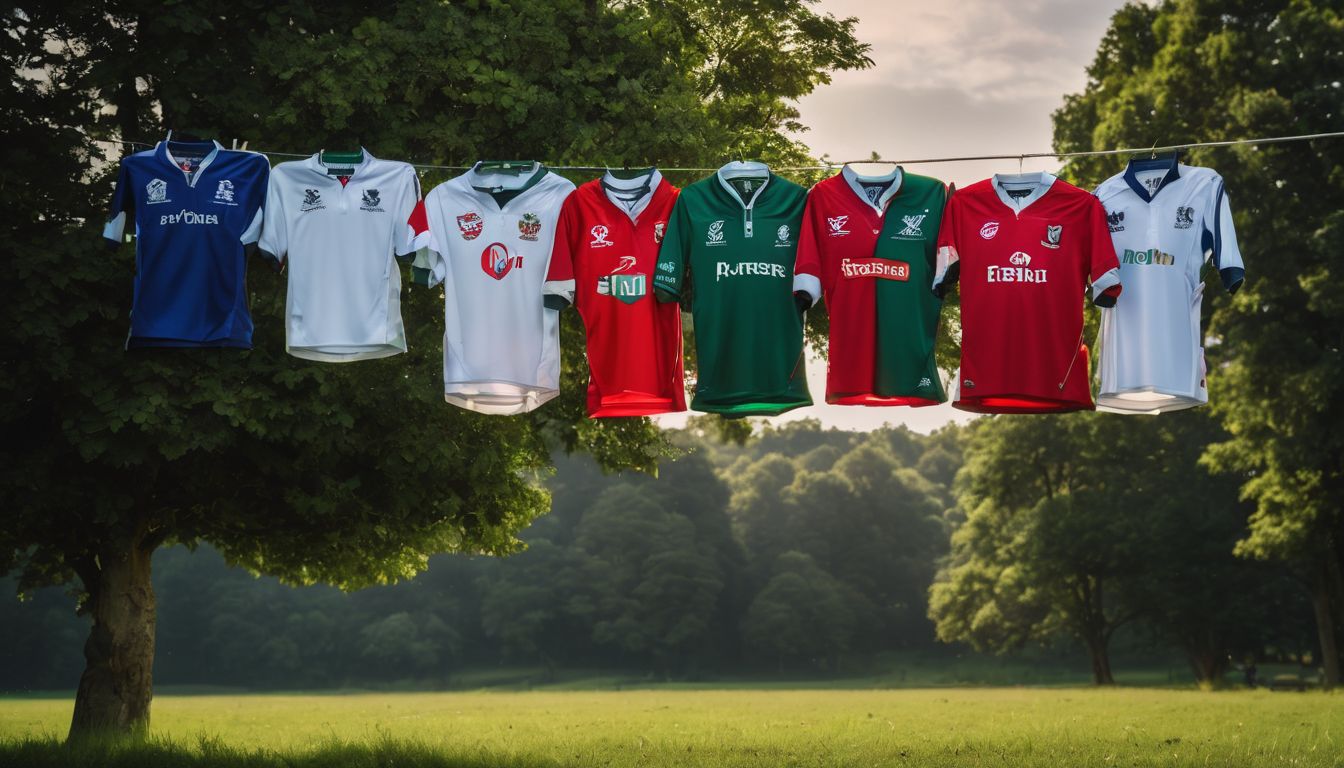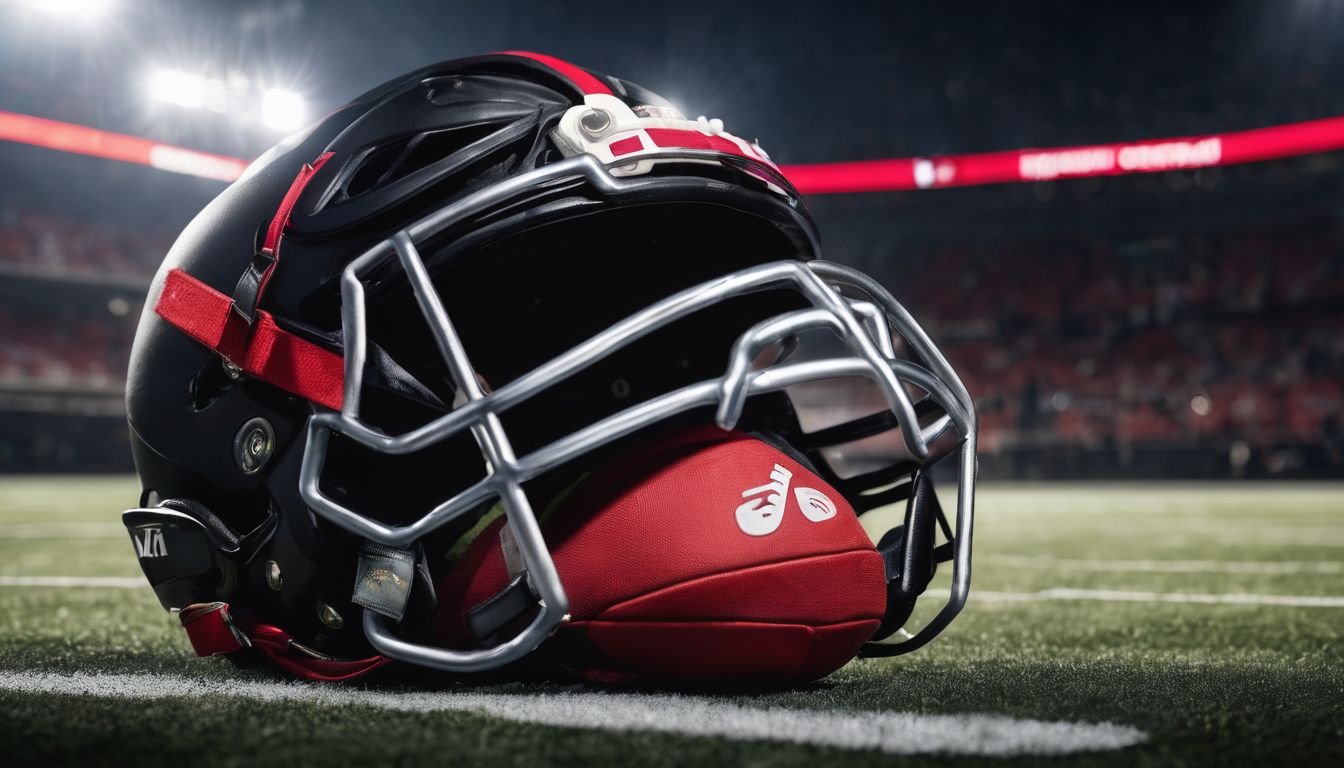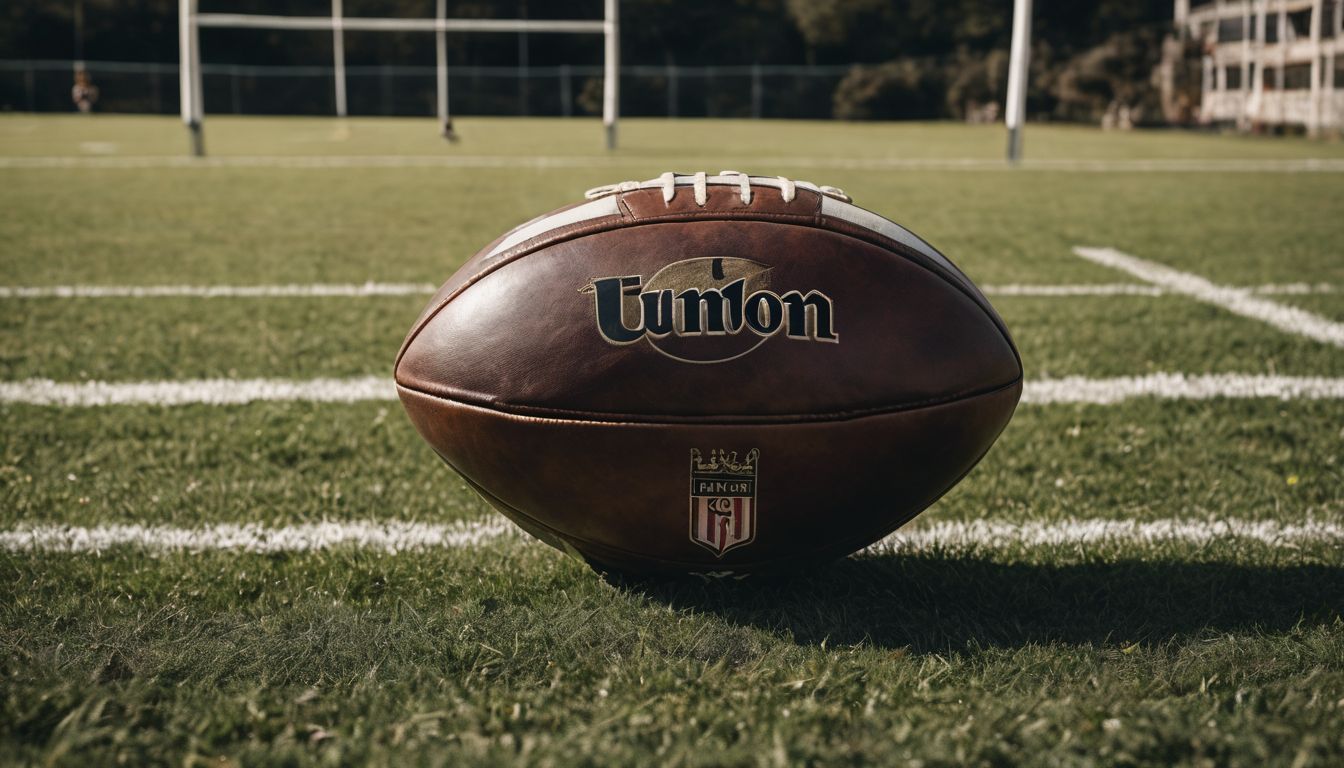Ever wondered why rugby teams wear such bold jerseys? Rugby shirts aren’t just for fashion; they symbolise unity and pride. This blog will dive into the colourful history of rugby jerseys and their meaning today.
Let’s discover what makes these team colours so special.
Key Takeaways
- Rugby jerseys originated from school uniforms, with colours and designs signalling academic pride and regional identity. New Zealand’s all-black kit exemplifies how practical choices evolved into iconic emblems.
- Jersey materials have advanced over time, incorporating features like moisture – wicking fabrics and ergonomic designs to boost player performance while also reflecting teams’ essence visually through vibrant colours and logos.
- Striped patterns such as hoops, bars, and chevrons on rugby jerseys not only enhance visibility on the field but are also steeped in tradition, reinforcing team identities and fostering unity among players and fans.
- Fans feel a strong bond with their rugby teams through their jerseys’ colours and designs, creating an inclusive community that shares a passion for the sport across diverse backgrounds.
- The uniqueness of team jerseys has vast marketing potential; replica sales generate revenue for clubs while offering sponsors valuable exposure during televised matches.
The Origins of Rugby Jerseys and Colors
Rugby jerseys and colors can be traced back to the origins of school uniforms, where different colors and designs helped distinguish teams. Over time, the influence of regional and professional clubs has also played a significant role in shaping the evolution of rugby jerseys and team colors.
You are currently viewing a placeholder content from Default. To access the actual content, click the button below. Please note that doing so will share data with third-party providers.
More InformationTracing back to school uniforms
School uniforms are where the story of rugby jerseys begins. Many teams took inspiration from their educational institutions, adopting vivid hues and distinctive designs that symbolised academic pride.
Picture young players charging across school fields, their striped or solid-colour jerseys reflecting a heritage that would soon weave into national sports culture.
Colours chosen for early rugby team uniforms often held deep significance, touching on aspects of local identity or profession. For instance, New Zealand’s famous all-black kit started as a practical solution to outfit an entire squad consistently but grew to become an emblem known worldwide.
These colours and styles laid down by schools set the foundation for the tradition-rich rugby jerseys we see today.
Influence of regional and professional clubs
Tracing back to school uniforms, the influence of regional and professional clubs has significantly impacted the evolution of rugby jerseys and team colors. Many teams adopted their traditional colors from local areas or professional affiliations, creating a strong sense of identity and pride among players and fans alike.
The choice of team colors often reflects the history, culture, and traditions of the region or club, contributing to a deeper connection between the team and its supporters.
Rugby’s association with regional and professional clubs has led to an array of unique jersey designs that represent specific communities or industries. These distinctive color schemes have become emblematic of each club’s heritage, fostering a deep sense of loyalty among fans.
The Evolution of Rugby Jerseys
Rugby jerseys have come a long way in terms of design, materials, and technology. This evolution has played a role in the emergence of team identities and traditions within the sport.
You are currently viewing a placeholder content from Default. To access the actual content, click the button below. Please note that doing so will share data with third-party providers.
More InformationChanges in design, materials, and technology
- Introduction of moisture – wicking fabrics that help players stay dry and comfortable during intense matches.
- Utilisation of lightweight yet durable materials to enhance flexibility and mobility on the field.
- Incorporation of advanced ventilation systems to improve breathability and regulate body temperature.
- Adoption of ergonomic designs to ensure a tailored fit for players, reducing potential distractions during gameplay.
- Implementation of seamless construction techniques for reduced friction and enhanced durability during tackles and scrums.
- Integration of modern printing technologies for vibrant, long – lasting team colours and logos that resist fading or peeling.
- Innovation in padding and protective elements to enhance player safety without compromising agility or range of motion.
- Use of sustainable and eco – friendly materials in response to growing environmental concerns within the sporting industry.
The emergence of team identities and traditions
Moving from changes in design, materials, and technology to the emergence of team identities and traditions, it is notable that rugby jerseys carry a historical significance. The choice of colors and designs reflects the heritage and pride associated with each team.
These jerseys not only signify unity on the field but also serve as a representation of cultural values, regional identity, and national pride. Furthermore, the adoption of specific colors or symbols for teams has contributed to the creation of traditions that extend beyond just the game itself.
The evolution of rugby shirts mirrors an ongoing commitment to representing team essence through visual elements like color, design, and symbolism. This has played a pivotal role in fostering a sense of belonging among players and fans alike while preserving time-honored sporting traditions.
The Significance of Striped Jerseys in Rugby
Striped jerseys in rugby serve a dual purpose of enhancing visibility on the field and building a sense of unity and tradition within the team. Different types of striped designs, such as traditional hoops, bars, and chevrons, have evolved over time to represent the unique identity and history of each team.
You are currently viewing a placeholder content from Default. To access the actual content, click the button below. Please note that doing so will share data with third-party providers.
More InformationEnhancing visibility on the field
Rugby team jerseys, with their bold colors and striped designs, serve the crucial function of enhancing visibility on the field. The vibrant hues and contrasting stripes make it easier for players to spot their teammates amidst the fast-paced action, thereby facilitating seamless coordination during matches.
This aspect is particularly vital in rugby, where quick decision-making and accurate passing are essential for gameplay success.
The color choices and striped patterns also aid spectators in distinguishing between teams at a glance, adding to the excitement of watching a live match or following the action on screen.
Building a sense of unity and tradition
Team jerseys and colors in rugby play a pivotal role in fostering a sense of unity and tradition among players and fans. The choice of colors often reflects the team’s identity, history, and values, creating a visual representation of the team’s pride and solidarity.
Additionally, when players don their team’s jersey, it instills a strong sense of belonging and camaraderie as they step onto the field. As each player wears their uniform with the same colors and designs, it signifies that they are part of something bigger than themselves – a unified force ready to compete as one.
The tradition of wearing specific colors or designs also resonates deeply with fans who proudly display the team’s colors at matches or events. This tangible connection between players and supporters further strengthens the bond within the rugby community.
Different Types of Striped Designs in Rugby
Striped designs in rugby jerseys come in various forms, including traditional hoops, bars, and chevrons, each with its unique historical and cultural significance. Modern interpretations and innovations have also contributed to the diversity of striped designs in rugby uniforms.
Traditional hoops, bars, and chevrons
Striped rugby jerseys are a classic design, with traditional hoops, bars, and chevrons being popular choices. Hoops feature parallel horizontal bands across the jersey, while bars consist of vertical stripes.
Chevrons form a V-shape pattern on the front or back of the jersey. These designs not only add visual interest but also serve to distinguish players from different teams on the field.
The bold and striking nature of these patterns enhances visibility during fast-paced gameplay, allowing fans to easily identify their favourite players.
Patterns like hoops, bars, and chevrons hold historical significance in rugby as they reflect longstanding team traditions and identities. When donning these distinctive designs, players embody their team’s rich history and evoke a sense of unity among teammates.
Modern interpretations and innovations
From traditional hoops, bars, and chevrons to modern interpretations and innovations in rugby jerseys, the sport has seen a shift towards sleeker designs and advanced materials. Rugby apparel companies are continually pushing boundaries with cutting-edge fabric technology that enhances performance on the field.
Modern jerseys incorporate moisture-wicking properties to keep players dry and comfortable during intense matches. Additionally, innovative designs such as sublimation printing allow for intricate patterns and vibrant colors that capture the essence of a team’s identity.
These developments not only elevate the aesthetic appeal of rugby shirts but also contribute to enhancing team unity and pride.
The use of sustainable materials is gaining momentum within the industry, signaling a move towards environmentally friendly practices in jersey manufacturing. Many teams are embracing eco-friendly fabrics as an integral part of their commitment to sustainability.
Impact of Team Jerseys and Colors
Team jerseys and colors in rugby play a crucial role in uniting fans and creating a sense of belonging, as well as expressing team pride and identity. Additionally, they have significant marketing and financial implications for both the teams and sponsors.
Uniting fans and creating a sense of belonging
Rugby team jerseys and colors hold immense significance in uniting fans and fostering a sense of belonging among supporters. The striking colors and unique designs of the jerseys serve as powerful symbols that bring fans together, creating a strong bond rooted in team pride and identity.
Whether it’s the national jersey representing their country or the club’s colors signifying local loyalty, fans feel a deep connection to their team through these visual representations.
This sense of unity extends beyond the players on the field, forming an inclusive community where individuals from diverse backgrounds come together under one shared passion for rugby.
The emotional attachment to team jerseys goes beyond mere aesthetics, with colors serving as rallying points during matches, gatherings at pubs, and even special events celebrating the sport.
Fans proudly don their favorite team’s colors, projecting a unified front that echoes across stadiums and virtual platforms alike. Additionally, it can be noted that rugby teams make deliberate decisions about their kit colours — often choosing shades with historical or cultural relevance—further strengthening the ties between fans and their beloved teams.
Expressing team pride and identity
Team pride and identity are expressed through the vibrant colors and distinctive designs of rugby jerseys. These iconic garments serve as a powerful symbol of unity for players and fans alike, fostering a sense of belonging and camaraderie within the team.
The choice of colors often reflects historical significance or national pride, with many teams adopting traditional hues that represent their country’s flag. Additionally, symbols or emblems incorporated into the design further reinforce the team’s identity and heritage, creating a strong visual representation of shared values and aspirations.
Through these jerseys, players proudly showcase their loyalty to their team while inspiring fervent support from passionate fans who don these colors with pride.
Rugby jerseys not only unite players on the field but also create an enduring connection between teams and their supporters. As fans sport their team’s colors, they become part of a collective identity that transcends individual differences, fostering a deep sense of belonging within the larger rugby community.
Marketing and financial implications
Rugby team jerseys and their colors have a significant impact on the marketing and financial aspects of the sport. The design and color scheme of rugby jerseys serve as a powerful branding tool, allowing teams to create merchandise that resonates with fans.
This not only fosters a sense of belonging among supporters but also opens up lucrative revenue streams through the sale of replica jerseys, apparel, and other related products. Furthermore, the distinctiveness of team colors enhances visibility during broadcasts, attracting potential sponsors keen on reaching wider audiences.
The significance of team jerseys in rugby also extends to sponsorship deals and partnerships. Companies are drawn to invest in teams whose brand identity aligns with their own values or target markets, resulting in mutually beneficial relationships.
Conclusion
In conclusion, team jerseys and colors in rugby hold a significant role in promoting team identity and unity. The evolution of rugby shirts reflects changing trends in design, technology, and cultural significance.
The choice of colors often represents pride for the country or locale, instilling confidence in players. Team jerseys not only unify fans but also carry historical significance and symbolism within the sport.
FAQs
1. Why are team colours important in rugby?
Team colours in rugby create a strong sense of identity and unity, while also making the teams easily recognisable to fans during matches like the Rugby World Cup.
2. What do the colours on a rugby jersey mean?
The symbolism of rugby team colours often has historical significance, representing national pride or club traditions that form part of the sport’s deep-rooted heritage.
3. Has the design of rugby jerseys changed much over time?
Yes, the evolution of sports uniforms includes significant changes in rugby jersey history, with kit designs becoming more advanced for performance and branding purposes.
4. Are there specific rules for rugby jerseys at major tournaments?
Indeed, during events such as the Rugby World Cup, there are strict regulations governing kit colours to ensure clarity and distinction between competing teams on the field.
5. How does a team choose its jersey colour in rugby?
Choosing a team’s jersey colour can involve many factors including historical importance of rugby jerseys, traditional club symbols, or creating a unique brand identity for fan recognition and impact.
















